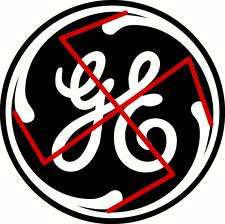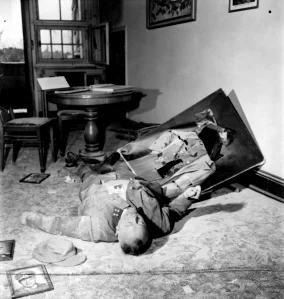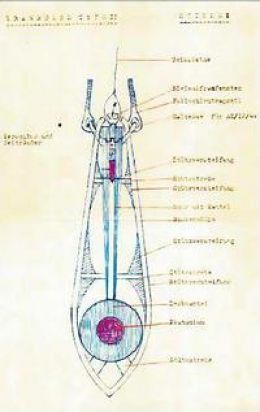Alex Constantine - January 21, 2012
 1946: Not for the first time and not for the last, the giant General Electric Co. found itself in federal court on charges of violating anti-trust law. The U.S. government charged GE and a corporate ally with conspiracy to monopolize a market, raise prices and drive out competitors.
1946: Not for the first time and not for the last, the giant General Electric Co. found itself in federal court on charges of violating anti-trust law. The U.S. government charged GE and a corporate ally with conspiracy to monopolize a market, raise prices and drive out competitors.
But this was no ordinary anti-trust case. The year following the end of World War II, GE stood accused of criminal conspiracy with Krupp, a major German munitions firm. Their partnership artificially raised the cost of U.S. defense preparations while helping to subsidize Hitler’s rearmament of Germany. The arrangement continued even after Nazi tanks smashed into Poland.
GE was not alone among U.S. big business in having cordial, profitable arrangements with the corporations of Nazi Germany. Kodak, DuPont and Shell Oil are also known to have had business dealing with Germany. Due to a recent reparations case, the activities of General Motors and Ford are the most well known. And the cases are instructive:
GM and Ford, through their subsidiaries, controlled 70 percent of the German automobile market when war broke out in 1939. Those companies "rapidly retooled themselves to become suppliers of war materiel to the Germany army," writes Michael Dobbs in the Washington Post.
"When American GIs invaded Europe in June 1944, they did so in jeeps, trucks and tanks manufactured by the Big Three motor companies in one of the largest crash militarization programs ever undertaken," observes Dobbs. "It came as an unpleasant surprise to discover that the enemy was also driving trucks manufactured by Ford and Opel — a 100 percent GM-owned subsidiary — and flying Opel-built warplanes."
The major U.S. automakers (including Chrysler) established multinational operations as early as the 1920s and 1930s, locating plants in Germany, eastern Europe and Japan.
FRIEND OF THE FUHRER
It wasn’t all strictly business. Henry Ford, a notorious anti-Semite, formed a kind of mutual admiration society with Adolf Hitler. The German dictator enthusiastically applauded American mass-production techniques. "I regard Henry Ford as my inspiration," declared Hitler, who kept a life-size portrait of the American industrialist next to his desk. In 1938, Ford accepted the highest medal that Nazi Germany could award a foreigner, the Grand Cross of the German Eagle.
Ford had a role in Nazi Germany’s prewar military buildup. U.S. Army Intelligence reported that the "real purpose" of the truck assembly plant opened in Berlin in 1938 was to produce "troop transport-type vehicles for the Wehrmacht (German military).
A senior executive of General Motors also received a medal from Hitler, apparently for services rendered, and services to come. GM’s involvement in Germany began in 1935 with the opening of a truck factory near Berlin. Within a few years trucks produced by that factory would be part of German Army convoys rumbling through Poland, France and the Soviet Union.
After the German occupation of Czechoslovakia in 1939, GM Chairman Alfred P. Sloan commented that the Nazis’ behavior "should not be considered the business of the management of General Motors." The GM plant in Germany was highly profitable. "We have no right to shut down that plant," Sloan declared.
TRUCKS FOR TYRANNY
GM and Ford were vital components of the Nazi war effort. German Ford was the second largest producer of trucks for the Nazi military. GM’s plants built thousands of bomber and jet fighter propulsion systems for the Luftwaffe — while at the same time profiting from production of aircraft engines for the U.S. Army Air Corps.
"The outbreak of war in September 1939 resulted inevitably in the full conversion by GM and Ford of their Axis plants to the production of military aircraft and trucks," according to a 1974 report printed by the U.S. Senate Judiciary Committee. "On the ground, GM and Ford subsidiaries built nearly 90 percent of the armored ‘mule’ 3-ton half-trucks and more than 70 percent of the Reich’s medium and heavy-duty trucks. These vehicles, according to American intelligence reports, served as ‘the backbone of the German Army transportation system.’"
"General Motors was far more important to the Nazi war machine than Switzerland," says researcher Bradford Snell. "Switzerland was just a repository of looted funds, while GM was an integral part of the German war effort. The Nazis could have invaded Poland and Russia without Switzerland. They could not have done so without GM."
GOING ALONG
Company officials have maintained that the Hitler government took over their German plants and that they "lost control" of the situation. But documents discovered in German and American archives show that in some cases, American managers of both Ford and GM seem to have gone along with the conversion of those plants to military production.
"When American GIs liberated the Ford plants in Cologne and Berlin, they found destitute foreign workers confined behind barbed wire and company documents extolling the ‘genius of the Fuhrer,’" writes Michael Dobbs.
Shamelessly, after the war both GM and Ford demanded reparations from the U.S. government for damage to their German plants caused by Allied bombing. In 1967, GM was compensated with $33 million from the U.S. government for the American bombing of its Russelsheim plant.
GE GOES GLOBAL EARLY
 Compared to Ford and General Motors, GE’s involvement appears less overt and extensive than that of the automakers. But it is nonetheless instructive, showing GE’s more complex relationship to the Third Reich.
Compared to Ford and General Motors, GE’s involvement appears less overt and extensive than that of the automakers. But it is nonetheless instructive, showing GE’s more complex relationship to the Third Reich.
As early as 1904, GE began joining forces with major foreign "competitors" to carve up world markets for crucial goods and technologies. In that year GE reached agreement with AEG (Allgemeine Elektricitäts Gesellschaft). The following year GE established a relationship with Tokyo Electric. GE’s early alliance with German firms was only temporarily disrupted by World War I. GE acquired 16 percent of AEG stock and placed four of its officials on the AEG board. It also obtained a stake in Siemens, Germany’s other big electrical manufacturing company.
GE’s patent agreements and minority stock ownership with German and Japanese corporations protected the domestic market while gaining access to foreign markets.
It was GE’s conspiracy with the German steel company Krupp that affected the U.S. war effort and dragged the company into a New York courtroom.
Both GE and Krupp had patents for tungsten carbide, a hard metal composition valued for its use in cutting dies and machining metal. Neither company’s patents were good enough to set up a monopoly. But jointly they could influence the world market.
Discussions between GE and Krupp began in April 1928. A GE representative asserted that his company’s willingness to enter new lines of business was dependent upon "the extent to which they can discourage competition." Eight months later they had an agreement which allowed GE the right to fix prices. GE set up a separate subsidiary, Carboloy, to handle the business.
Immediately, the price of tungsten carbide went from $48 to $453 a pound.
GE used the agreement to cripple — or buy out — domestic competitors. When the head of American Cutting Alloys appealed to GE to be permitted to remain in business, he was told by a GE official: "It seems rather obvious to me that five suppliers in the American market all supplying carbides is a better situation than six suppliers."
In its agreement with Krupp, GE agreed to sell tungsten carbide (also known as carboloy) only in the western hemisphere, and to pay royalties to Krupp. Gustav Krupp, owner of the company, was a major corporate backer of Adolf Hitler. Both before and after Hitler’s rise to power, GE’s royalties indirectly subsidized the Nazis.
In 1935, as the U.S. government began defense preparations, tungsten carbide (at GE’s prices) was regarded as too expensive.
AGREED TO PROTECT THE NAZIS
On Dec. 11, 1939 (nine weeks after the Hitler attack on Poland), the representative of International General Electric cabled from Berlin to GE official Dr. Zay Jeffries: "Our friends at Osram Co. [a German lighting company linked to GE] informed me yesterday that Krupp would be interested in capitalizing the royalties now being received from Carboloy... In this connection, Dr. Louis (a Krupp official) has asked for an appointment with me in Zurich where we shall both be next week. They are quite anxious that the Krupp name be kept out of correspondence, particularly telegrams that might reach improper hands and therefore I shall refer to them in the future either as the European licensor under Carboloy contract or simply as Dr. Louis..."
"The ‘improper hands’ could be either the United States government or the governments of Europe which had been attacked by Hitler," reported the UE NEWS in 1948. "GE agreed to protect the Nazis.
"In 1940, with the American defense moves in full swing, GE was still reporting to the Nazi representatives, now stationed in Zurich, Switzerland, how much tungsten carbide was being used in the United States. GE paid royalties to the Nazis on every pound used here. That was money for the Hitler war chest."
In other words, Hitler was getting 12 pounds of tungsten carbide at the price the U.S. government was getting one pound. For every pound of the material sold in the U.S., Hitler through Krupp was getting royalties with which he bought more munitions.
In 1940, with Europe at war, Krupp arranged to have its royalties from GE collected by a Swiss go-between.
BUSTED
As late as August 1940, nearly a year after Hitler attacked Poland, GE was seeking renewal of its monopoly agreement with Krupp. But the GE-Krupp deal came to an end as a result of a lawsuit — and an embargo the U.S. government clamped on shipment of money to the Nazis.
The Firth-Sterling Steel Co., which sought to sell shell turning blanks to the U.S. Army, Frankford Arsenal, ran afoul of GE’s price levels and complained to the U.S. Justice Dept.
In September 1940, the UE NEWS reported that two federal anti-trust indictments had been returned against GE and the Krupp company, charging them with having conspired to maintain worldwide monopoly in the production and sale of tungsten carbide. U.S. entry into World War II interrupted the proceedings, however.
‘PRINCIPAL BOTTLENECK’
In the meantime, a subcommittee of the Senate Committee on Military Affairs took an understandably dim view of how international cartels had hindered the anti-fascist war effort. The Senate subcommittee charged that the GE-Krupp arrangement had created a bottleneck in production of tungsten carbide. "In contrast with the situation in Germany, the present drastic shortage of this essential material in this country is notorious," stated John Henry Lewin, special assistant to the Attorney General. "The need to produce it, to retool our manufacturing plants with it, and to instruct workmen in the use of such tools has constituted one of the principal bottlenecks in our production program."
There was no tungsten carbide to meet military needs. There were no independent manufacturers — GE had crippled them.
The trial resumed in New York on Jan. 26 1947. Under indictment were GE Vice Pres. Zay Jeffries; Pres. W.G. Robbins of the Carboloy Co., and Walter M. Stearns, former GE trade manager. Gustav Krupp, held as a war criminal in Germany, was not present, although he, too, was indicted.
Ironically, Jeffries had accused UE leaders as having "un-American objectives" and denounced high wages.
INCRIMINATING DOCUMENTS
During the trial GE attorneys bitterly fought the introduction of German documents seized by the U.S. military. In one such document, indicted GE conspirator Walter Stearns was quoted as telling the Germans that while GE intended to fix prices, "this must never be expressed in the contract itself or in any correspondence which might come into the files of GE."
The court also heard testimony from U.S. companies pressured by GE not to buy from competitors. The president of one company, Union Wire Die, testified that Dr. Jeffries had warned him: "We’ll either buy you out or break you."
GE, its subsidiaries and company officials were found guilty on five counts of criminal conspiracy with Friederich Krupp A.G. of Essen, Germany.
Summing up his opinion on one of the five counts, Judge John C. Knox declared: "Competitors were excluded by purchase and by boycott; prices on unpatented products were fixed, future patent rights were forced into the pool, world markets were divided, and on occasion prices were fixed beyond the scope of any asserted patent protection..."
Judge Knox concluded: "defendants did unlawfully monopolize."
WRIST-SLAPPING
However, the court declined the Justice Department’s request for heavy penalties, including jail time. Stearns and Jeffries were fined $2,500 each and Robbins $1,000. GE and Carboloy were fined $20,000 each and International GE only $10,000 — even though the profits GE made through its conspiracy with Krupp must have run into many millions of dollars.
In 1935 and 1936 alone, GE’s subsidiary Carboloy made a profit of $694,000. On top if that it paid GE $454,000 as a manufacturing profit and another $300,000 as interest on a loan from GE during the period of the monopoly.
Ironically, reports on the trial and conviction were buried or ignored by many newspapers, at a time when GE allegations that UE members employed at atomic energy facilities were potential security risks were prominently displayed on the front page. The UE NEWS (with a circulation of more than 700,000) was the only newspaper courageous enough to cover the trial consistently and dig out the facts of the story.
"While the working people of America were giving everything to the anti-fascist war effort, that effort was being hindered by international cartel agreements of big business," write Richard O. Boyer and Herbert M. Morais in Labor’s Untold Story.
(This article was written and researched by UE NEWS Managing Editor Peter Gilmore, with research and consultation by UE Research Dir. Lisa Frank and UE Archivist David Rosenberg. Much of the article, however, is based on the reportage of retired UE NEWS Managing Editor James Lerner, who covered the GE-Krupp conspiracy trial.)










No comments yet.